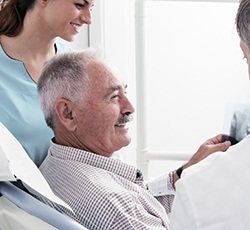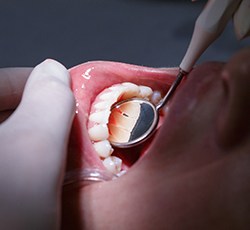
Connective Tissue Grafting in Lovell
Once it has been lost, gum tissue does not grow back. If you are experiencing gum recession, you will likely need connective tissue grafting -- or gum surgery -- to replace the tissue that has been lost. But don’t worry, the procedure is not as bad as it may sound! Dr. Lance Anderson is your dentist in Lovell providing comfortable connective tissue grafting.
Why Gum Recession Occurs

After you have lost gum tissue, you may wonder how recession occurs in the first place. Your gums can pull away from the teeth for a number of reasons. Aggressive tooth brushing is a common reason for recession. Make sure you are brushing your teeth in gentle circles with a soft bristled brush to protect your sensitive gum tissue.
Poor dental hygiene is another factor that can cause gum recession. When you do not brush for two minutes twice a day, floss daily, and visit the dentist regularly, you are likely to develop gum disease. This infection causes the gum tissue to pull away from the teeth.
You may not notice your gum recession at first, but over time, your teeth will become increasingly sensitive as more of the tooth and its root are exposed. Gum recession can also be an unsightly problem, causing the teeth to look too long.
Fortunately, connective tissue grafting is an effective solution for replacing the tissue lost by receding gums.
Connective Tissue Graft: How It Works

Dr. Anderson can use your own healthy oral tissue to replace what’s been lost around the gums. A connective tissue graft is the most common type of gum grafting used to cover up exposed roots. To perform the procedure, Dr. Anderson administers local anesthesia and sedation as desired for your complete comfort. Then, he removes a small amount of tissue from the roof of your mouth by cutting a bit of skin from the palate and taking the tissue from beneath. This portion of the palate is called the subepithelial connective tissue.
This small piece of new tissue is then carefully stitched to the area where it has been lost around the gums, covering the exposed root and restoring the appearance of full, healthy gums. The palate is stitched closed, and the procedure is complete. Sometimes, the new tissue is taken not from your own mouth but harvested from a tissue bank. You and your dentist can discuss which option is best for your connective tissue graft.
Recovering After a Gum Graft

After your procedure is complete, you will experience the side effects common to any oral surgery. Discomfort, swelling, and minor bleeding may occur in the hours and days following your treatment.
Do not brush or floss the treatment area right after your procedure. Maintain a soft foods diet and take your pain medication as directed by Dr. Anderson. Stay on top of follow-up visits and notify him immediately if you experience uncontrollable bleeding or excessive discomfort or swelling around the treatment area.Side effects should go away after a week or two, and you will be back to feeling great with your new gums.
Have any questions about connective tissue grafting in Lovell? We invite you to contact Lovell Dental to schedule an appointment.